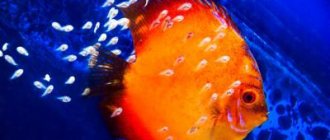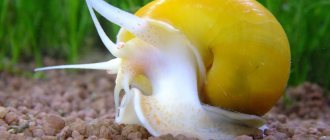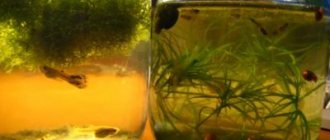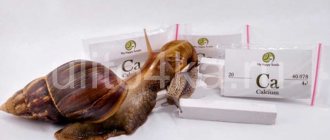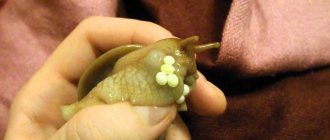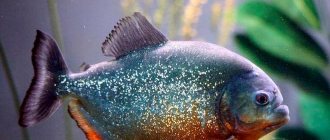Freshwater snails are found in the rivers and lakes of central Russia. These mollusks can be recognized by their large external spiral-shaped shell, from which a leg with a flat bottom surface and a pair of tentacle horns are visible. The size of snails ranges from 5 mm to 6 cm. The river snail either crawls on aquatic plants or sits quietly; it cannot swim. While moving, the snail indiscriminately eats everything that gets in its way.
Aquarium owners often want to diversify their living area and add various pets to it. River snails are no exception in this case, but in order for them to live long and please their owner, they need to create conditions that are as close to natural as possible.
Maintenance and care at home
Snails are recognizable mainly because of their slowness. They are considered plant pests in the garden. Invasive snails also appear in aquariums and are a big problem (they need to be controlled in various ways). However, most species (from tropical areas) play an important role as "scavengers". Some of them are predators and dangerous to fry or other small creatures (such as shrimp).
Almost all snails have very poor tolerance to water that is too soft and acidic (then they lack the minerals needed to build shells).
In order for a mollusk to build a strong shell, the water in the aquarium must be hard and saturated with calcium.
But snails are also hardy, adapting to any conditions, including temperatures from +18-28°C. It is better not to take them from reservoirs into your aquarium, but to buy them at a pet store. They live better in warm water and reproduce more actively. But too much birth rate is also bad.
An important point for aquarium snails is the soil. Streets prefer coarse or fine sand, but soil 1-2 mm in size is also suitable.
Some species are escapees. For example, for large apple snails, the aquarium should be tightly closed, and 2 cm of space should be left between the surface of the water and the lid for free breathing and for laying eggs.
Representatives of the genus Tylomelania are more demanding (they need crystal clear, oxygenated water with a fairly high temperature). Caring for them can be recommended to more experienced aquarium lovers.
For comfortable living, the volume of the aquarium is the same as for aquarium fish: 1 aquarium snail needs 10 liters.
Land
These are some of the popular types of pets. There are several types of mollusks representing this subgroup. Most land snails belong to the Achatina species. The second most common representative is the grape snail.
Achatina
The size of these gastropods sometimes reaches 25 centimeters. Body color varies from light brown to green. When maintaining, a container with a volume of 25–30 liters is required with the obligatory presence of soil. It must be kept moist at all times. They feed on plants, fruits and vegetables. Banana slices serve as a delicacy. The diet must contain protein foods. Daphnia and gammarus are used as feed.
There are a huge number of varieties of Achatina. Of the most interesting and unusual individuals, the following can be distinguished.
- Achatina fulica is a lazy mollusk. In his free time from eating, he prefers to relax in the house. Its size reaches 20 centimeters. Females are fertile and lay large numbers of eggs. The shell has a conical shape. The colors come in a variety of colors. In the wild, there are individuals of brown, cream and dark color. She leads a terrestrial lifestyle. This type of land snail is capable of laying up to 400 eggs during the breeding season.
- Achatina iradeli is an unusual species of snail, as it has the ability to give birth to viviparity. During the mating process, parents change sex. About 20 snails are born at a time. The color of the shell of the mollusk is yellowish. It uses berries and fruits as food, as well as rotten cabbage leaves. It has pulmonary breathing, which allows the snail to live on land.
Grape
This is a large land mollusk that lives in forests, meadows and parks. The width of the grape snail's shell reaches 45 millimeters. Its color is usually yellowish. Life expectancy ranges from 5 to 7 years. It feeds on plants and vegetables. The diet contains burdock, cabbage, and dandelion leaves. It loves moisture and hides under stones and other shelters during dry periods. Before the onset of cold weather, he leads an active lifestyle. When the temperature drops, it enters a state of suspended animation.
Table of basic parameters of maintenance, care and nutrition:
| What should be the volume of the aquarium? | for most types from 10 liters for some types from 90 liters |
| What should the temperature be? | from +18-30° C depends on the type |
| What pH should it be | from 6.5-8 pH |
| What should be the stiffness? | from 8-18° dH |
| What should the substrate be? | coarse or fine sand, fine grains of substrate (soil) 1-2 mm in size |
| What kind of lighting should there be? | moderate |
| What should be the movement of water | moderate |
| Maximum size | from 1.5-9 cm, depends on the type |
| What does it eat? | aquarium algae: healthy or rotting; fish food; raw or boiled vegetables |
| Type of aquarium snail | depends on the type: peaceful; predators |
| Who is compatible with in an aquarium? | compatible with all peaceful aquarium inhabitants |
| Lifespan | from 1-5 years depending on the type and conditions of detention |
Marisa
A freshwater snail from South America belonging to the Ampullaridae family.
Appearance
An amazing mollusk with a large golden shell that curls like a lamb's horn can become a real decoration for an aquarium. The snail shell is decorated with dark stripes. The diameter reaches 6 cm. The body color can be white or dark with pigment spots on it.
Lifestyle
Maryse is considered the lawnmower of the aquarium world, and is therefore not welcomed by most aquarists. Eats any plant food, as well as caviar of mollusks and other fish. The lifespan of a mollusk is from 2 to 4 years. This species lives peacefully with other inhabitants, but serves as food for predatory fish.
Snail reproduction is bisexual. Females and males differ in color. The body of males is speckled gray, while that of females is dark brown. The female lays eggs, attaching them to the wall of the aquarium, a pebble or a plant leaf. After 2 weeks, small individuals will emerge from the eggs, capable of feeding on their own. The survival rate of young individuals is very low.
Content requirements
The tropical mollusk marise lives and reproduces well in water with a temperature of +25 C of medium hardness. At lower temperatures, this species does not reproduce, and at temperatures below +20 C it dies. There are no special requirements for water acidity.
They need an aquarium with a volume of at least 20 liters, open or closed. Requirements for water acidity – 7 Ph. Water may be of medium hardness or higher. It is recommended to use a good filtration system in the aquarium, which will prevent excessive reproduction of shellfish.
Basics of care and feeding
The snail is unpretentious to lighting. Regardless of whether the marise has additional food, the aquarium algae will still suffer. Therefore, aquarists categorically do not recommend introducing this type of voracious creature into the ecosystem. Maryse living in an aquarium can be fed with vegetables: pieces of zucchini, cabbage.
Did you know? The first mentions of artificial reservoirs and the selection of their inhabitants date back to the reign of the Tang Dynasty in China (618-907 AD). And the first aquarium was invented only in the 19th century.
What to feed aquarium snails
Aquarium snails do not feed on healthy plants (except invasive species). Therefore, the opinion that they destroy the structure of the aquarium is erroneous. Clams feed on detritus - decaying organic matter (for example, excess food or rotting pieces of greenery). For some members of the family, algae are the main food.
In the absence of food (such situations rarely occur in aquariums), they feed on fish food. They can also be fed raw vegetables, which need to be poured with boiling water for 5-10 minutes - carrots, cabbage, beans. You can also feed them with specialized food.
Large ampularia readily eat fish products in tablets, raw cucumber slices, frozen spinach, steamed or frozen lettuce, and even frozen plankton.
Tylomelania
A species of freshwater snail from Indonesia in the family Pachychilidae Troschel.
Appearance
Tilomelania is a mollusk with a cone-shaped shell that can be of various colors. The shells are smooth, covered with spikes, with curls. The length of the shell can vary from 2 to 12 cm. The color combination of the body and the shell is very diverse. The eyes rise above the body on long thin legs.
Did you know? Thylomelania looks like the result of an amazing genetic experiment. The snail's trunk is similar to the trunk of an elephant. And the body is like a slice of exotic bright yellow fruit.
Lifestyle
The lifespan of this tropical species is 2-3 years. The mollusk is very fond of rocky base and water with high acidity. This species of gastropod is omnivorous and eats everything: plants, other snails, fish food. Due to the excessive gluttony of the mollusk, it is advisable to feed it 2-3 times a day with leftover vegetables. If there is a lack of nutrition, the snail will start eating aquarium vegetation.
Extremely aggressive towards other inhabitants of the ecosystem. This beauty is a natural predator, eating all shellfish that are smaller than its size, and also eats the eggs of shellfish and fish. That is why it is not recommended to house tilomelania with other species. This mollusk is bisexual. The female carries one egg and is viviparous.
Content requirements
A small aquarium can only accommodate a few shellfish. A population of 4-5 snails needs a container with a volume of at least 60 liters. Comfortable water temperature – at least +25 C, acidity at least 7.5 Ph. The water must be hard because in soft water the process of softening the sink begins. Tylomelania does not tolerate bright light, so the aquarium must be equipped with shelters where the mollusk could hide on a sunny day.
You cannot house them with other species unless you want to reduce their population.
Basics of care and feeding
To preserve aquarium vegetation, the mollusk needs to be fed several times a day with pieces of vegetables: cucumber, zucchini, tree leaves. Tylomelania readily eats fish food and aquarium organic matter.
Aquarium snails: species with photos, names and descriptions
There are many types of aquarium snails. All the most common types of aquarium snails are described here:
Ampularia
Ampularia is the most famous species of exotic snail, native to South America. The shell reaches 10-12 cm. There are many color options. The most common are yellow, brown, white or mixed. The apple snail has no ears, it is completely deaf, has poor vision, and recognizes only light and dark places.
The temperature in the aquarium should be from +20-25° C. Hardness from 8-18° dH. Acidity from 6.5-7.8 pH. Aquarium volume from 10 liters.
These are bisexual mollusks and require a pair to reproduce. Males and females are difficult to distinguish externally. It does not reproduce as intensively as other small snails. Therefore, you need to create conditions: raise the temperature a little and increase the amount of food. Only at this temperature does it become active. After successful copulation, eggs are laid in the form of cocoons above the water (in an aquarium on glass or on a lid).
In good conditions they can live from 3-5 years. The combination of lungs and gills in the respiratory system reflects their adaptation to life in oxygen-deficient waters.
Melania
The Melania snail is a freshwater species that originally originated in Southeast Asia and is now widespread throughout almost the entire world in subtropical, tropical and temperate climate zones.
Size up to 3 cm. It has a twisted elongated cone-shaped shell with up to 12 turns. More often found in brown or olive tones with marbled highlights.
A very useful aquarium creature, cleaning the bottom in search of food and protecting them from anaerobic zones. During the day it usually remains in hiding, only after turning off the light does it appear on the glass of the aquarium.
It feeds on food debris left by fish, fish droppings and detritus. They have a high oxygen requirement and are useful, but over time they can become a pest in the aquarium. This species is viviparous and reproduces very quickly.
The temperature in the aquarium is from +22-28° C. Life expectancy is up to 2-3 years.
Coil
The aquarium snail Coil is one of the popular aquarium snails with a brown, grayish, dark blue, almost black and sometimes even red shell. The color is affected by the presence of hemoglobin because these snails, like humans, have red blood. Is a hermaphrodite. It multiplies too quickly.
There are several types of coils:
- Horn Coil;
- Coil Wrapped;
- Far Eastern coil;
- Keeled coil;
- Reel Horny Red.
The temperature in the aquarium is from +22-28° C. Life expectancy in the wild is up to 4 years in the aquarium up to 2-3 years.
Decoration: long antennae that look like horns. The shell is completely round, its diameter reaches about 1.5 cm. The mollusk is easy to grow. It eats food left by fish, fish droppings, detritus, algae, dead plant debris and periphyton.
Fiza
The Physa snail is a small species of snail. It has an oval shiny shell, inflated at the entrance, with a curl of 3-4 turns. Grows up to 1.5-2 cm in length. The shell is light brown. These snails feed on algae and leftover food from aquarium fish. They are voracious and secrete a lot of mucus.
There are several types of physical:
- pointed;
- vesicular;
- red;
- marmorata.
Temperature from +20-30° C. Life expectancy from 1.5-2 years.
They reproduce quickly, constructing “egg bridges” containing about 100 eggs. Due to their high fertility, the population of these creatures in the aquarium must be controlled. But they are also readily eaten by aquarium fish (for example, Ancistrus and Cichlids).
Neretina
There are more than 20 varieties of Neretin snails, which differ in appearance and colors: olive, brown-black with golden stripes. Also, all species grow up to 2 cm in size, except for the tiger and zebra, which grow up to 3-3.5 cm. The Neretina snail is freshwater, but some representatives live in salt and brackish waters.
They feed on plaque in the aquarium on the glass of the aquarium; they perfectly clean the aquarium of algae deposits. Plants are not damaged. You also need to feed cereal flakes and an algae called spirulina. They are active day and night, sometimes taking rest breaks. In case of “escape”, this snail will not be able to go without water for long - it will die.
“Escape” can happen due to:
- bad water in the aquarium;
- small amount of oxygen;
- too little food.
There will be no issues with overpopulation, because Neretina larvae need brackish water for development.
The lifespan of neretina is from 1-2 years, but there are varieties of neretina that live up to 5 years. Temperature from +24-30° C. Acidity from 6.5-8 pH. Hardness from 6-20° dH.
Helena
The Helena snail lives in rivers and lakes of Indonesia, Thailand, and Southeast Asia. This beautifully colored snail with a cone-shaped shell resembles a regular auger, but its coloring is more regular. Light yellow and dark brown stripes with strong pigmentation are arranged alternately and contrast effectively with each other. Each turn is ribbed with decorative inserts.
They grow to about 2 cm in length. These are predators that eat their relatives, equipped with a tube with which they “suck out” the body of the victim. The recommended temperature is +23-27° C, but it reproduces more often at temperatures above +25° C. At a temperature of +20° C, the Helena snail stops reproducing. Water hardness should be from 8-15 dH. Acidity from 7-8 pH.
Tylomelania
All species of tilomelania snails originate from the Indonesian island of Sulawesi. The diversity of species among tylomelanas is directly determined by their natural habitat - mainly the soil in which they live and the type of water from which they originate (still or flowing).
It reaches a length of up to 12 cm, the shell is cone-shaped and durable. The eyes, like two beads, are located on “legs”. Bisexual animals, fertilization is internal.
The male, equipped with a copulatory organ, fertilizes the female, and the sperm is deposited in the seminal reservoir (it can be stored there for a long time and used if necessary). After fertilization, the female releases the embryos (their number and size depend on the specific species) sequentially into a special chamber.
Tilomelania reproduce continuously, with females constantly releasing the next largest embryos, so these snails reproduce quite quickly. They feed on diatoms and detritus.
The Tilomelania snail has a good appetite. Feeds:
- zucchini;
- spirulina;
- green vegetables (cabbage, cucumber);
- shrimp food;
- live food;
- fish meat.
The temperature in the aquarium is from +27-30° C. The acidity of the water is from 8.3-8.6 pH. Life span is 5-7 years.
Horned
The horned snail lives in rivers, streams, canals, estuaries and deltas of New Guinea, the Philippines, Indonesia, Japan and Taiwan. This is a freshwater species.
There are a large number of varieties of horned snails, so they are found in different color shades. It is characterized by protruding spines (or horns) that act as a defense mechanism against natural predators. The spikes are randomly distributed and can also damage human skin.
This is a calm snail that does not bother other inhabitants of the aquarium (fish and shrimp). Size depending on type from 1-3.5 cm.
Active, but moves slowly, likes to escape from the aquarium and crawl on land. Eggs are laid when the environment in which they live is full of food. It feeds on aquarium algae: healthy or rotting, fish food, raw or boiled vegetables.
Water temperature is not lower than +24° C. Hardness is from 10-13° dH. Acidity from 7 pH. Life span is from 1-5 years.
Theodoxus
The Theodoxus snail is from the Neritid family; its maximum size is 2 cm. The homeland of these snails is Poland, the Baltic states, Ukraine, southern Russia, Belarus, some areas of Hungary and several species can be found in the Azov, Black and Baltic seas.
In essence, it is an assistant in the aquarium. She eats aquarium plants, thereby “trimming” them, and also constantly cleans the walls of the aquarium, decorations, and aquarium plants from plaque and does it better than catfish or shrimp.
To keep 1 individual, you need an aquarium of 1 liter in size, but due to its small size, it is better to keep at least 10 individuals (1 individual in the aquarium will be invisible). And for reproduction you need at least 10 individuals.
Water temperature from +20-30° C. Acidity from 5.5-7 pH. Hardness from 10-20° dH.
Marisa
The snail Mariza loves to “travel”, so you need to cover the aquarium so that Mariza “runs away”. Marisa breathes atmospheric air, so you need to cover the aquarium so that there is a small gap left.
The size of the shell reaches up to 6 cm. The color of the shell is:
- grey;
- light brown with black spiral stripe.
This snail is ideal for an aquarium with a lot of vegetation that needs to be trimmed frequently. The main diet is healthy aquarium vegetation, which can be eaten down to the root.
Maryse snails can live in salt water, but they will not reproduce in such water. For Mariza snails, temperatures from +21-25° C, water acidity from 7-8 pH, hardness from 8-15° dH are suitable. With proper maintenance, it lives up to 4 years.
A female and a male are required to reproduce. The eggs are laid on any surface convenient for the female.
Black mystery
Native to Brazil, there are 120 species. This snail breathes using a process (siphon). She can push this process out of the water and swallow air.
It reaches up to 5 cm in diameter and is most often black in color. The female is larger than the male. Peaceful, low maintenance, omnivorous. Eats algae deposits on the walls of the aquarium and the remains of fish food.
Temperature from +20-30° C. Acidity from 6.5-8 pH. Hardness from 12-18° dH. Lives from 3 to 5 years.
Bitinia
At its core, the Bitinia snail is an aquarium cleaner. It penetrates into hard-to-reach places in the aquarium, thereby thoroughly cleaning the aquarium from bacteria and fungi.
The shell of Bitinia is strong, but only if there is calcium in the water. There are several shell colors: dark brown or light brown.
Reproduction requires a female and a male. The female lays her eggs on any surface in the aquarium that she likes.
There are several types of Bithinia snails:
- Bitinia tentacleta;
- Bitinia Licha;
- Bitinia Bloated.
Depending on the species, the size of an adult can be from 1.5-12 cm. Temperature is from +22° C. They live from 1.5-5 years, also depending on the species.
The Bithinia snail can be a helper, but it can also be a pest - it is a carrier of parasitic worms, for example, double-barreled worms.
Devil's thorn
The aquarium snail Devil's Thorn is a fairly large mollusk, its shell width reaches 2 cm and its length is 8 cm. The Devil's Thorn has several species. The main shell colors are brown, light brown and black. Body color may be orange, marbled or yellow.
Habitat in nature: Southeast Asia. This snail is also found in muddy rivers that border the sea coast. It lives in North and South America, Madagascar and southern Africa.
It feeds on plaque in the aquarium, fish food, and raw or boiled vegetables.
Temperature from +25-28° C. Acidity from 7-8.7 pH. Hardness from 5-20° dH. The water should be salty: 1 tbsp. spoon of sea salt per 3 liters of water.
If all requirements are met, the lifespan is up to 5 years.
Luzhanka
The Luzhanka snail is one of the few viviparous snails that gives birth to already formed young. The shell color can be yellow or dark yellow with a light brown or brown spiral. There is a lid on the “leg” of the lawn and when it hides the body in the sink, it closes with this lid “closing the door behind itself.”
The Luzhanka snail is demanding of cleanliness in the aquarium, essentially due to the fact that it breathes oxygen, which dissolves in water. He also likes to dig in the ground, so the soil should be coarse or fine sand, or soil with a granule size of 1-2 mm. Digging in the ground, she gets her food. Therefore, the question regarding what to feed is not worth it, but feeding with calcium-containing feed will be useful.
Temperature from +24° C. The size of an adult reaches from 2-4.5 cm - depending on the species.
There are several types of Luzhanka snail:
- Striped Swamp Lawn;
- A real river Luzhanka.
Life expectancy is 8-10 years.
Spixie
Spixie snail shell color is white with a dark brown spiral or yellow with a dark brown spiral. The body may be brown or yellow with a few dark spots. The size of the female does not exceed 3 cm, the male up to 2 cm.
The Spixie snail hides in the ground during the daytime, and stays awake when darkness falls (if there is no soil in the aquarium, then the difference between night and day is no longer important).
For example, Ampulyaria, due to its weight, cannot maintain itself in a suspended state for a long time, but Spixie is able to maintain its weight at any height.
Eggs are laid on any surface in the aquarium.
Temperature from +22-28° C. Acidity from 6-8 pH. Hardness from 8-10° dH. Lifespan in an aquarium is up to 5 years.
River Dreissena
The Dreissena polymorpha snail is a bivalve mollusk that can live in brackish and fresh waters. The shell is triangle-shaped and up to 5 cm long. The color of the shell is:
- light yellowish with brown stripes;
- white with brown stripes;
- greenish with brown stripes.
This snail has gills through which it breathes and feeds.
The rule of 10 liters per 1 snail does not apply to this snail! You need an aquarium of at least 90 liters with a temperature of +18-27° C. Lives from 5-8 years.
Tiara
The Tiara snail is scary-looking and has thin needles on its shell that look like weapons. But this is only in appearance; these needles are flexible and delicate hairs that do not pose any danger. The size of this snail does not exceed 3 cm in length.
Feeds:
- aquarium plants;
- live food;
- spirulina;
- granules;
- nori (pressed seaweed);
- pieces of vegetables.
The color of the shell can be: dark yellow, brown or cream. Often limescale deposits form in the grooves of the shell.
Thiara cancellata's natural habitat is the islands of the Pacific and Indian Oceans. Also on the island of Bohol in the Philippines in brackish and fresh water with tides.
Temperature from +22-26° C. Acidity from 7.2-8.2 pH.
Zebra
The Zebra snail is also called Neretina. There are several varieties of the Zebra snail. She is unpretentious and adapts to any conditions. At its core, an aquarium assistant cleans everything in the aquarium.
The size of the Zebra snail reaches up to 2 cm. This snail has a light and dark yellow color and a black or dark brown spiral.
An aquarium of 10 liters or more is suitable for its maintenance. Does not harm aquarium plants and other aquarium inhabitants. Temperature from +22-26° C. Acidity from 7.2-8.2 pH. For reproduction, salt or salt water is needed. They live up to 3 years.
Ampularia mystic snails (Pomacea)
This is one of the varieties of ampularia, one of the most common in aquariums. Quite large, calm, peaceful snails, live 3-4 years, grow to almost 4 cm. These are very active algae eaters and attractive in appearance. The snail's body may be black or pink-orange with neon orange spots around the head. The shell can be brown or olive in color, yellow, gold, with dark, white, maroon, golden yellow or blue stripes.
Mysterious ampullaria eat green algae, fallen leaves of aquarium plants, and carrion. This species has gills, as well as lungs with a so-called siphon tube, with the help of which they can breathe air while rising to the surface. They can rise to the edge of the aquarium and fall out, so the aquarium must be securely covered.
Apple snails require both sexes to reproduce, and the female must be able to leave the water to lay her eggs. The eggs of these snails look like honeycombs on glass above the water or on a lid. Young snails hatch after 2-3 weeks, depending on the temperature, and fall into the water.
Aquarium snails breeding
There are many aquarium snails that breathe through gills and reproduce sexually and asexually, lay eggs or are viviparous.
Some species are bisexual (hermaphrodites), that is, one individual is enough to bear offspring. Unfortunately, this is often the case for species that are considered invasive. Among the domestic hermaphrodite species: coil (Planorbarius corneus) and physa (Physa). Species that require a male and a female for reproduction: ampularia, helena, gimlet, tilomelania, marise.
Reproduction methods vary from person to person. Snails can lay eggs in water (for example, attaching them to rocks, plants) or above the surface of a water surface (for example, on glass and lids). Then you can unwittingly destroy the cubs by adding water. Snails can also develop offspring in their own body (augers). Sometimes reproduction is very difficult (or impossible), since the larvae, after hatching from the eggs, require salt water and sea plankton (Vittina Semiconica, Zebra Nerites).
The owner of the aquarium has a certain influence on environmental factors for reproduction - maintaining optimal water temperature, creating shelter and potential places for laying eggs, and also providing enough food.
In aquariums for snails, the presence of predators (gourami fish, pufira fish, Leporinus group) should be avoided. Young snails may be at risk for several months because their shells are not yet fully hardened.
What role do snails play in an aquarium?
The appearance of snails in an aquarium sometimes occurs unnoticed. Observing the life going on there, the aquarist suddenly notices that on the wide leaves, walls, shells or just the ground, a small scattering of pebbles has appeared, hard to the touch and almost black in color. After a few days it becomes clear: these are young snails. In bright light, their reddish or brown color is visible. They move quickly, and at the moment of movement, a tender soft body appears from a dark shell, half of which is a leg.
At the moment of danger, the snail hides itself in a calcined house and waits out the danger there. She recognizes it with the help of a pair of neat horns and eyes located at their base.
The babies are brought into the aquarium along with the soil or vegetation in which the eggs were laid. It is light and hardly visible to the naked eye. Each egg eventually produces a small snail. It burrows into soft soil for its development and growth. After a couple of months, a viable individual appears in the water and begins its activity:
- quickly moving along the walls, with its mouthparts it scrapes off mucus and green growths from them, thereby providing a service for maintaining the sanitary condition of the artificial reservoir;
- pick up the remains of food intended for fish. By eating this kind of debris that has settled to the bottom, they fight possible decay processes and prevent the release of decay products into the water;
- Some species of snails feed on fish carrion, thereby preventing organic water pollution.
But all the described activities are nothing in comparison with the practical benefits of biological regulation of the number of snails themselves.
Diseases
Most often, diseases arise due to improper maintenance. If you do not feed the snail with calcium, the shell will begin to deteriorate. And you can also add eggshells, shells or chalk (all crushed) to the water. The cuttlefish skeleton (there are a lot of proteins there) can be lowered into the aquarium, the snails will gradually scrape it off.
If there are indentations on the sink, these are most likely mites. You should carefully remove the pet from the water, blot the shell with a soft cloth, then wipe it with a cotton swab soaked in formaldehyde. Protect the animal from getting this liquid on its body.
A white coating on the shell indicates the presence of other parasites. Then you need to place the snail in a salt solution (10 g per 1 liter of water), hold for 15 minutes.
Due to lack of oxygen, the animal may fall into a coma and because of this, the snail may not crawl out of its shell. The clam should be transplanted into a jar of clean water.
Sometimes diseases include green plaque on the sink. But this is not so, you just need to clean the shell with a soft toothbrush (without soap or other products).
Conclusion
Some species help keep the aquarium clean by reaching where human hands and tweezers cannot reach. These mollusks are part of different environments and provide food for many organisms, so they should be considered a necessary and important part of any aquatic ecosystem.
Ampularia in the wild
The homeland of ampullaria is the waters of South America, where this species of gastropod was first discovered in the waters of the Amazon River.
Appearance and description
Ampullaria are very diverse in appearance, lungfishes, represented by both small representatives of the family and very large snails, whose body sizes reach 50-80 mm. The ampularia has an attractive, curled, light brown shell with very distinctive dark brown stripes .
This is interesting! This type of snail breathes very specifically, using gills located on the right side of the body for this purpose. When rising from the water to the surface, the ampularia inhales oxygen using its lungs.
This unusual tropical mollusk has a large horny cap, which is located on the back of the leg. This cap is a kind of “door” that allows you to close the mouth of the shell. The snail's eyes have an interesting yellowish-golden color. The mollusk is characterized by the presence of special tentacles, which are organs of touch. A fairly well-developed sense of smell allows the ampularia to accurately and quickly determine the location of food.
Distribution and habitats
In natural wild conditions, ampullaria are not very rare . This snail has become widespread and settles in large numbers in rice fields, where it poses a serious threat to the ripening crop.
Despite its tropical origin, the gastropod quickly spread throughout many countries, so in some regions it is necessary to deal with the rapid growth of the ampularia population. An overgrown snail population can cause significant harm to wetland ecosystems, and also greatly displaces other species of gastropods.
Amipularia snail color
The most common are individuals with classic coloration in yellowish-brown tones of varying degrees of saturation. However, quite often there are snails whose colors have more saturated tropical colors and unusual shades.
This is interesting! There are ampularia with exotic bluish, pink, tomato-colored, white, brownish-black original coloring.
